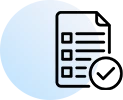Count Every Page
Easily find out how many pages a website has in total. Just enter the site link or sitemap URL and hit “Count Pages” to see all the pages instantly.
Scan All Sitemaps
The tool checks your sitemap and collects all the page links (URLs) listed in it. Once done, it shows you the full list of pages found in a simple format.
Sort Modified URLs
The tool arranges all the modified URLs found in the sitemap by year and month, so you can quickly spot how your site updates are spread over time.
Download as CSV
Export all sitemap URLs or modified URLs as a CSV file. You get two options: choose whichever list you want, and download it within seconds.
How to Find Number of Pages Using Website Page Counter
Step 1: Insert the Site URL or Sitemap URL in the box
Step 2: Click on Count Pages to get result
Website page counter is a tool that tells you how many pages or links your website has. Using this tool, you will be able to find out how many links are on your site.
By getting to know the number of web pages your site has, you can understand if all website URLs are successfully indexed by Google or not. Thanks to the website page counter which made this possible for you to count pages for free.
Why Should You Use Website Page Counter?
A website page counter can be used to keep track of the number of pages in a website’s sitemap. Make sure you have your website’s sitemap in the first place because you won’t be able to count pages without having a sitemap. A sitemap is a place where all of your pages on a website are listed, and gets submitted to Google to help them crawl and index the site.
Additionally, a sitemap also helps in providing the website visitors an easy access to the pages that they want to navigate and find the content they are looking for.
If you are a website owner or developer, a sitemap counter comes out to be a useful tool for you as it allows you to determine the number of pages. With this information in hand, a page counter can be used to ensure that all pages on the site are included in the sitemap, calculate whether they are indexed by the search engine and monitor changes to the site’s structure and content.
Moreover, it is important to detect and fix URLs with errors and 404s. So, it’s best to do your audits regularly and find all URLs on a domain to know the status of your site.
There are a variety of sitemap page counters available online, ranging from simple tools that count the number of URLs in a sitemap to more advanced tools that provide additional information and analysis. However, whatever website page counter you use, it is important to ensure that the tool is reliable and accurate. With our website page counter, you don’t have to rely on others to help you count URLs your sitemap has. This tool is fast and 100% accurate.
No matter how large your sitemap is or how complex your site is, our website page counter does a deep scan to provide you the total links on your site precisely.
When Do You Need a Sitemap Page Counter
Here are a few cases where you may need a website sitemap page counter:
- Creating or updating a sitemap: If you are building a new website or updating an existing one, it is important to ensure that your sitemap is complete and accurate. A sitemap page counter can help you easily count the number of pages in your sitemap, which can help you ensure that all of your pages are included.
- Monitoring changes to your website: If you are making changes to the structure or content of your website, a free website page counter can help you keep track of these changes. By counting the number of pages in your sitemap before and after making changes or any page delete, you can ensure that all of your pages are still included in the sitemap.
- Ensuring URLs in Sitemap: By using a sitemap counter, you can ensure that your sitemap is complete and accurate, which can help improve your website’s visibility in search engine results pages.
- Analyzing Competitors: The website counter can be used to determine how many links are on the website of your competitor. It provides an exciting chance to do competitor analysis for free.
Frequently Asked Questions:
Q1. Can this Tool Scan More Than One Sitemap?
Yes, if your website uses more than one sitemap file, just enter each link separately. The tool will scan all of them and collect the page links for you.
Q2. Does It Check If Any Pages are Missing or Broken?
No. The tool only reads the sitemap and shows all listed URLs. It does not verify if pages are working, missing, or broken. However, if you want to check inactive links, you can visit our broken link checker.
Q3. How are Modified URLs Organized?
The tool arranges modified URLs by year and month based on the “last modified” date. This helps you track updates and get all pages of a website in a clean, sorted way.
Q4. Can I Export Lists of URLs?
Yes, you can download the entire sitemap URLs or the year-wise sorted URLs (sorted on the basis of when each URL was last modified) as a CSV file. It is a one-click export, super handy for SEO audits or sharing with your team.
Q5. Can This Tool Count Pages for Large Websites, too?
Yes. Even if your site has thousands of pages, our web page counter will handle everything. So, feel free to drop your big-fat website’s webpage address, as there are no limits on how many pages you can process.
Q6. Do I Need to Log In or Pay to Get All Pages of a Website?
Well, it is a completely free link extractor tool that you can use as many times as you want without hidden charges or credits. Best of all, we don’t force you to sign up on our website first and then use our tool. Which means you can work here without wasting your time.
Q7. Can I See When Pages were Last Updated?
Yes, the tool organizes modified URLs by year and month. So, you can clearly get all pages of a website and see when you or your team last updated them.






